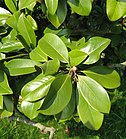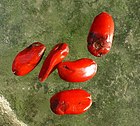Note: This is a project under development. The articles on this wiki are just being initiated and broadly incomplete. You can Help creating new pages.
Difference between revisions of "Magnolia grandiflora - Him Champa"
| (20 intermediate revisions by 2 users not shown) | |||
| Line 1: | Line 1: | ||
| − | [[File:Magnolia | + | [[File:Magnolia flower Duke campus.jpg|thumb|right|''Magnolia grandiflora'']] |
| − | |||
'''Magnolia officinalis''' is a species of Magnolia native to the mountains and valleys of China at altitudes of 300–1500 m. | '''Magnolia officinalis''' is a species of Magnolia native to the mountains and valleys of China at altitudes of 300–1500 m. | ||
==Uses== | ==Uses== | ||
| − | {{Uses| | + | {{Uses|Menstrual cramps}}, {{Uses|Abdominal pain}}, {{Uses|Abdominal bloating}}, {{Uses|Gas problems}}, {{Uses|Nausea}}, {{Uses|Indigestion}}, {{Uses|Cough}}, {{Uses|Acute phlegm}}, {{Uses|Intestinal problems}} |
==Parts Used== | ==Parts Used== | ||
| − | {{Parts Used|Dried | + | {{Parts Used|Dried folaige}}, {{Parts Used|Whole herb}}. |
==Chemical Composition== | ==Chemical Composition== | ||
| Line 13: | Line 12: | ||
==Common names== | ==Common names== | ||
| − | {{Common names|kn=|ml=|sa=|ta=|te=|hi=|en=Chinese Magnolia, Choon Pok}} | + | {{Common names|kn=|ml=|sa=|ta=|te=|hi= हिम चम्पा Him champa|en=Chinese Magnolia, Choon Pok}} |
==Properties== | ==Properties== | ||
| Line 39: | Line 38: | ||
===Flower=== | ===Flower=== | ||
| − | {{Flower| | + | {{Flower|Unisexual|6 inches|Yellow|many|Flowers Season is June - August}} |
===Fruit=== | ===Fruit=== | ||
| Line 47: | Line 46: | ||
==List of Ayurvedic medicine in which the herb is used== | ==List of Ayurvedic medicine in which the herb is used== | ||
| − | |||
==Where to get the saplings== | ==Where to get the saplings== | ||
| Line 54: | Line 52: | ||
==How to plant/cultivate== | ==How to plant/cultivate== | ||
| − | + | Seed - best sown as soon as it is ripe in a cold frame. Stored seed must be kept cold over the winter and should be sown in late winter in a cold frame. The seed usually germinates in the spring but it can take 18 months. <ref name="How to plant/cultivate"/> | |
==Commonly seen growing in areas== | ==Commonly seen growing in areas== | ||
| − | {{Commonly seen|Tall grasslands}}, {{Commonly seen| | + | {{Commonly seen|Tall grasslands}}, {{Commonly seen|Meadows}}, {{Commonly seen|Borders of forests and fields}}. |
==Photo Gallery== | ==Photo Gallery== | ||
<gallery class="left" caption="" widths="140px" heights="140px"> | <gallery class="left" caption="" widths="140px" heights="140px"> | ||
| − | File: | + | File:Magnolia grandiflora Tree.jpg|Ocklawaha Restoration Area Marion County, Florida |
| − | File: | + | File:Starr 070830-8224 Magnolia grandiflora.jpg|Leaves |
| − | + | File:Magnolia grandiflora leaves by Line1.jpg|Leaves | |
| + | File:Magnolia grandiflora - flower 2.jpg|Flower | ||
| + | File:Magnoliafruit.jpg|Fruit | ||
| + | File:Magnolia grandiflora 2003.jpg|Seeds | ||
| + | File:Magnolia grandiflora seeds.jpg|Seeds | ||
</gallery> | </gallery> | ||
| Line 69: | Line 71: | ||
<references> | <references> | ||
| − | <ref name="chemical composition">[https://www.herbwisdom.com/herb-magnolia.html | + | <ref name="chemical composition">[https://www.herbwisdom.com/herb-magnolia.html Chemical properties]</ref> |
| − | <ref name="Leaf">[https://www.wildflower.org/plants/result.php?id_plant=magr4 | + | <ref name="Leaf">[https://www.wildflower.org/plants/result.php?id_plant=magr4 Plant charecteristics]</ref> |
| − | <ref name="How to plant/cultivate">[https:// | + | <ref name="How to plant/cultivate">[https://pfaf.org/user/Plant.aspx?LatinName=Magnolia+grandiflora Cultivation details]</ref> |
</references> | </references> | ||
| Line 80: | Line 82: | ||
[[Category:Herbs]] | [[Category:Herbs]] | ||
| + | [[Category:Magnoliaceae]] | ||
Latest revision as of 15:16, 29 May 2020
Magnolia officinalis is a species of Magnolia native to the mountains and valleys of China at altitudes of 300–1500 m.
Contents
- 1 Uses
- 2 Parts Used
- 3 Chemical Composition
- 4 Common names
- 5 Properties
- 6 Habit
- 7 Identification
- 8 List of Ayurvedic medicine in which the herb is used
- 9 Where to get the saplings
- 10 Mode of Propagation
- 11 How to plant/cultivate
- 12 Commonly seen growing in areas
- 13 Photo Gallery
- 14 References
- 15 External Links
Uses
Menstrual cramps, Abdominal pain, Abdominal bloating, Gas problems, Nausea, Indigestion, Cough, Acute phlegm, Intestinal problems
Parts Used
Chemical Composition
Anti-allergic, anti-asthmatic, anti-bacterial, anti-fungal, anti-septic, anti-spasmodic, anti-stress, anxiolytic, aphrodisiac, appetiser, digestive, diuretic, emmenagogue, expectorant, ophthalmic, stomachic, tonic, warming[1]
Common names
| Language | Common name |
|---|---|
| Kannada | |
| Hindi | हिम चम्पा Him champa |
| Malayalam | |
| Tamil | |
| Telugu | |
| Marathi | NA |
| Gujarathi | NA |
| Punjabi | NA |
| Kashmiri | NA |
| Sanskrit | |
| English | Chinese Magnolia, Choon Pok |
Properties
Reference: Dravya - Substance, Rasa - Taste, Guna - Qualities, Veerya - Potency, Vipaka - Post-digesion effect, Karma - Pharmacological activity, Prabhava - Therepeutics.
Dravya
Rasa
Guna
Veerya
Vipaka
Karma
Prabhava
Habit
Identification
Leaf
| Kind | Shape | Feature |
|---|---|---|
| Simple | alternate | Leaf Retention is Evergreen |
Flower
| Type | Size | Color and composition | Stamen | More information |
|---|---|---|---|---|
| Unisexual | 6 inches | Yellow | many | Flowers Season is June - August |
Fruit
| Type | Size | Mass | Appearance | Seeds | More information |
|---|---|---|---|---|---|
| simple | 7–10 mm | clearly grooved lengthwise, Lowest hooked hairs aligned towards crown | many | {{{6}}} |
Other features
List of Ayurvedic medicine in which the herb is used
Where to get the saplings
Mode of Propagation
How to plant/cultivate
Seed - best sown as soon as it is ripe in a cold frame. Stored seed must be kept cold over the winter and should be sown in late winter in a cold frame. The seed usually germinates in the spring but it can take 18 months. [3]
Commonly seen growing in areas
Tall grasslands, Meadows, Borders of forests and fields.
Photo Gallery
References
External Links
- Ayurvedic Herbs known to be helpful to treat Menstrual cramps
- Ayurvedic Herbs known to be helpful to treat Abdominal pain
- Ayurvedic Herbs known to be helpful to treat Abdominal bloating
- Ayurvedic Herbs known to be helpful to treat Gas problems
- Ayurvedic Herbs known to be helpful to treat Nausea
- Ayurvedic Herbs known to be helpful to treat Indigestion
- Ayurvedic Herbs known to be helpful to treat Cough
- Ayurvedic Herbs known to be helpful to treat Acute phlegm
- Ayurvedic Herbs known to be helpful to treat Intestinal problems
- Herbs with Dried folaige used in medicine
- Herbs with Whole herb used in medicine
- Herbs with common name in Hindi
- Herbs with common name in English
- Habit - Tree
- Index of Plants which can be propagated by Seeds
- Index of Plants which can be propagated by Cuttings
- Herbs that are commonly seen in the region of Tall grasslands
- Herbs that are commonly seen in the region of Meadows
- Herbs that are commonly seen in the region of Borders of forests and fields
- Herbs
- Magnoliaceae







